Landing pages are one of the cornerstones of digital marketing.
Any online marketer will tell you that increasing conversions on the landing pages is a primary goal of Digital Marketing. That’s why it’s important to understand the current best practices and how you can improve your own landing page strategy.
However, with so many landing page solutions and information out there, it’s hard to know which ones are worth your time.
That’s why we compiled the best data and found the most surprising trends and statistics with regard to a landing page. This guide will hopefully give you the confidence you need when creating or optimizing your landing pages.
Landing Page Statistics For Lead Generation & Better Conversion Rate
Landing page conversion rate optimization is no easy task, especially if you’re coming at it fresh with zero experience. There are many important factors that impact conversion rate and lead generation.
Let’s analyze some statistics, facts, and key trends to help you generate more leads and a better conversion rate with your landing page.
1. Landing page load speed is crucial for conversions
If you’re in the lead generation space, landing pages are going to be a big part of your marketing strategy. However, if your landing page is taking too long to load, you’re most definitely losing out on sales.
As per Neil Patel, a one-second delay in loading a website can lower conversions by 7%. And as per Portent, a landing page with a 0-2 second load time sees the highest conversion rate.

Portent also observed that potential sales dropped by over $250 in just a time span of ~4 seconds.
Even if every other element of your landing page is perfect, visitors will abandon your page if it takes too long to load.
2. Increasing your landing pages from 10 to 15 will Increase leads by 55%
Many people think that having one landing page is enough. But that’s not true; having multiple landing pages is far more effective.
As per HubSpot, companies that increase their number of landing pages from 10 to 15 get a 55% increase in leads.

When using multiple landing pages, you can change the emphasis depending on where the visitor comes from and what they’re looking for. More landing page also means more marketing opportunities and variety.
3. Average conversion rate of a landing page is 9.7%
As per WordStream, the average conversion rate of a landing page is 9.7% across all industries. It represents an approximate figure of a good conversion rate.

This number, however, is just based on averages, and there are many pages with much higher rates than that. Its value will fluctuate depending on the seasonality of your business, competition, and other factors.
4. Adding videos on a landing page can increase conversion by up to 86%
As per Wishpond, you can improve conversions by up to 86% if you add videos on landing pages. And as per Wyzowl, 86% of businesses are already using video as a marketing tool.
Scrolling down the page and reading a blog post is great. It gives us time to think, digest what we have read, and come up with new questions. However, visitors don’t always want to do this… scrolling.
On the contrary, videos help people become immersed in an experience which is why they’re more likely to convert more often. Naturally, people tend to spend more time on landing pages that have an embedded video, or a pre-roll video ad.
5. Landing pages with social proof lead to a higher conversion rate
According to Unbounce, landing pages with examples of social proof and testimonials usually have a conversion rate of 12.50%, while the ones without any social proof have a conversion rate of 11.40%.
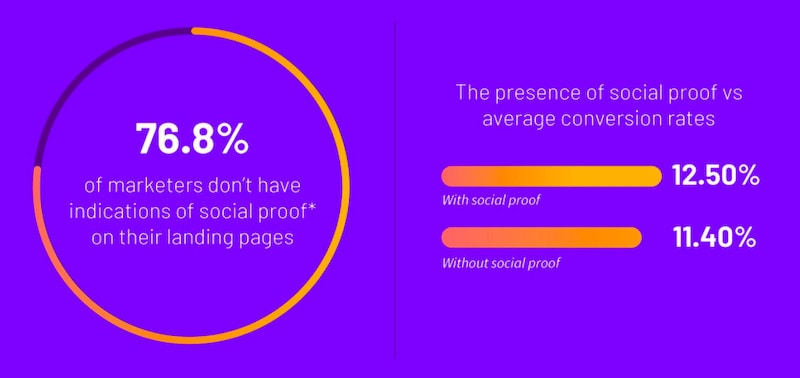
Social proof is a common technique used by marketers to convince skeptics. Rather than offering evidence, it refers to the use of direct statements, observations, and actions by third parties who provide some form of endorsement for your product or service. It can even be in the form of peer-to-peer testimonials.
Surprisingly, as many as 76.8% of marketers don’t have social proof indicators on their landing pages. You will shine even more if you leverage any form of social proof in your landing page.
6. The more landing pages you have on your site, the more leads you’ll generate
HubSpot’s research Lead Generation Lessons From 4,000 businesses states that companies that have 31 to 40 landing pages get seven times more leads as compared to companies with one to five landing pages.

If you’re using one landing page to convert your leads, why not use two? Or five? Or even 40? There’s no reason to constrain yourself when it comes to landing pages; you should be trying out a lot of different ones to gather as many qualified leads as possible.
7. Personalized CTAs in landing pages can lead to higher conversions
As per HubSpot, personalized CTAs can convert 202% better as compared to a generic CTA.
Building and optimizing landing pages rely on a lot of factors. Not only do they need to be optimized to convert and show the right message, but they also rely upon a call-to-action (CTA).
CTAs are often used to direct website visitors on where to take the next step in the conversion process.
8. Company branding in the title tag is a popular landing page strategy
Company branding in the Title Tag is an excellent landing page strategy for companies looking to boost their SERP rankings and increase website traffic to their site.
In fact, according to Nifty Marketing, 66% of top landing pages include their business names in the title tag.
9. Performing A/B tests on landing pages can lead to a higher conversion rate
Performing A/B tests or split testing on landing pages is crucial. When Highrise ran an A/B test, they saw 37.5% more conversions on their extended landing page.
Hubspot also states that about 17% of marketers implement landing page A/B tests to boost conversions.
The A/B testing process is often used by businesses to see which page produces the best conversion rate. This can include various elements, from design, color, and typography to text, pictures, and layout.
10. Combine images with content on your landing page
As per Venngage, users are 80% more likely to consume content if you combine it with images, which will eventually lead to a better conversion rate.
The importance of great images cannot be stressed enough. A picture is the easiest way to capture your readers’ attention and will help draw them in to read the content on your landing page.
11. Use conversion rate optimization tools to enhance your landing page marketing
As per Venture Beat, CRO tools can help you get up to 223% ROI on average.
This also indicates that good conversion optimization tools can help improve your landing pages’ conversions, which allows you to get more qualified leads on your landing page which can give each visitor a longer time on the site.
12. Addressing buyer concerns can increase landing page conversion rate by 80%
Marcus Sheridan, an international keynote speaker, claimed that he was able to increase his landing page conversion rate by 80% by addressing common buyer concerns.
“What is this?” “Why should I give you my email address? Nothing bad could possibly happen. You don’t even have a privacy policy.”
These are some of the most common concerns visitors on your landing page might have. Make sure to address beforehand what you’ll do with user information and data.
You also need to address the biggest of all Internet plagues: SPAM.
Nobody wants to receive it, because it ruins their experience online. So, most people tend to get wary when they see a checkbox in an email asking them whether or not they’re okay with receiving future emails from the sender.
It’s your duty to inform the user of the reason you’re asking for their details, how many emails can they expect from you – and a promise that you won’t spam their folder.
Look at this example below:

13. Including contact numbers on your home page can increase trust and conversions
As per Neil Patel, home pages with contact numbers invoke trust and help gain more conversions.
In an A/B test with two home page variations, the page with the phone number resulted in 53.96% of sign-ups – while the one without the phone number resulted in 46.04% of sign-ups.

By including your contact number on your homepage, your customers will feel more comfortable ordering from you. Whether they are in pre-purchase or purchase mode, this simple addition will increase trust and conversion rates.
14. Fewer links and navigation result in a higher landing page conversion rate
According to HubSpot, the more navigation you add to your landing, the lower your conversion rate will be.
This includes top navigation, sidebar navigation, footers, social media links, and more. Basically, everything that might distract your visitors from filling out the sign-up form.
Unfortunately, the same study suggests that as many as 84% of landing pages have navigation. You can take advantage of this fact by removing navigation from all your landing pages and standing out among your competitors.
You’ll notice that many of the top sites on the net have simple landing pages.
These pages seize your attention because they do not contain navigation or distracting content. The purpose of these pages is to focus your attention exactly where it should be, the offer placed in front of you.
15. Two-step landing pages are more effective
As per Databox, having a two-step landing page proved to be 30% more effective as compared to a regular one.
In a two-step landing page, you continue the conversion process by prompting people to submit additional details on a second web page after viewing your first web page.
You can also display a pop-up rather than directing your audience to a second web page.
Here’s an excellent example of a two-step landing page:

Rather than overwhelming the audience on a single landing page, it divides information into two parts.
When the visitor clicks on either of the two CTA buttons on the landing page above, they’ll come across a pop-up form.

Doing this effectively can lead to higher conversions than with a one-step landing page.
Landing Page Dont’s (Things To Strictly Avoid)
As website owners, most of us want to bring in as many visitors and leads to our businesses as possible.
One tactic that is quite popular with Digital Marketers is creating Landing Pages. However, there are some common mistakes that are made when we create them.
Let’s dive in and discuss Landing Page statistics that help you realize what to avoid while designing your landing pages.
16. Be wary of adding more than one link on your landing pages
A study by Unbounce revealed that pages with one clear call-to-action or link saw 13.5% conversions while pages with 2 to 4 CTAs or links saw only 11.9% conversions.
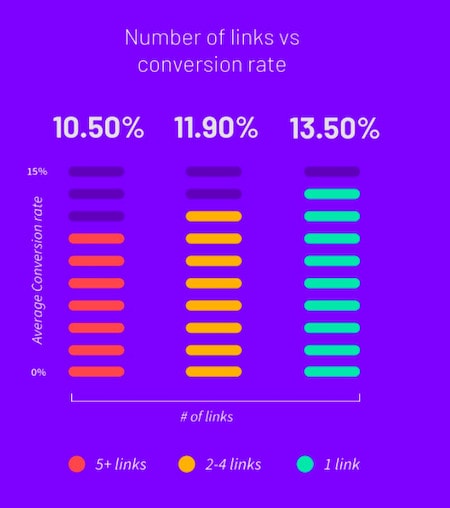
We all know that links pointing to our website helps us gain search engine traffic, but too many links can actually become intrusive.
There are good chances that your audiences are already bombarded with information and incentives to consume so much stuff that it can be overwhelming. Your aim should be to provide them with one valuable and targeted link.
17. Landing page conversion rates drop when companies ask visitors their gender
A survey by Omnisend suggested that visitors are more likely to convert if your landing page has fewer personal questions.
According to the survey, the conversion rate saw a drop from 10.15% to around 6% when the company’s sign-up forms asked for the target audience’s gender.
The best-performing sign-up forms are those that ask only for email and phone numbers.
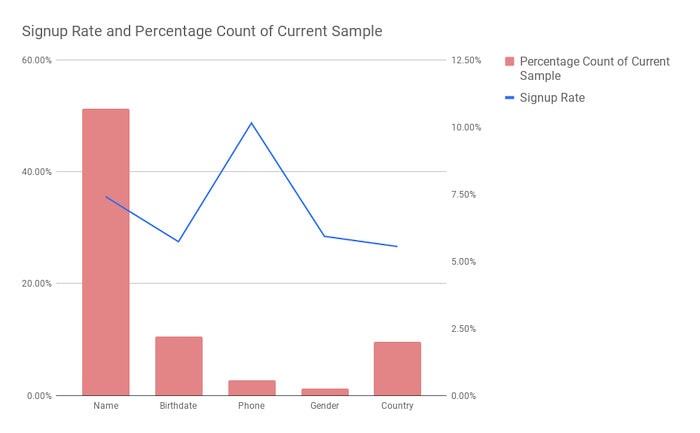
Landing pages have to be as friendly as possible. Users will probably only land on them once or twice. And the last thing you want is a user to land and exit right away because they’re thrown off by a personal question or something that is offensive to them.
Aside from personal questions, avoid asking too many questions even if they’re impersonal or entirely inoffensive. To get your reader’s attention, you need to keep your landing page simple and clear. Do not fill out your page with lots of things the user does not understand or care about.
18. 29.5% of landing pages have too much copy
As per Unbounce, 29.5% of landing pages have too much copy. The study revealed that business sector landing pages that have fewer than 100 words converted 50% better as compared to those with 500 words or more.

The old saying “wordiness is the enemy of understanding” rings true in online marketing. The more words we use to describe something, the harder it becomes for your readers to understand. This is especially true for landing pages.
Fewer words and shorter sentences are better because they increase your chance of being understood, and not just getting skimmed. The shorter the text on your page, the better will be your conversion rate.
19. Too many offers reduce landing page conversions by up to 266%
According to the statistics roundup by Bluleadz, placing numerous offers on landing pages could reduce conversions by up to 266%.
This shouldn’t come as a big surprise to you, since most of us have trouble focusing on more than one thing at a time.
People are busy. A recent study has shown that the average attention span is just 8 seconds – that’s around the same amount of time a goldfish can concentrate on a thing.
So when you overload your offers with a lot of different tiers or different ways to qualify, it’s going to scare away potential customers and reduce your conversion rate. It’s better to only have one attractive offer at any given time.
20. Eliminating the navigation menu from your landing page can increase conversions by 100%
When Yuppiechef conducted an A/B test to discover whether they need a navigation menu on their landing page or not, the test revealed that eliminating the navigation menu increased conversions by 100%.
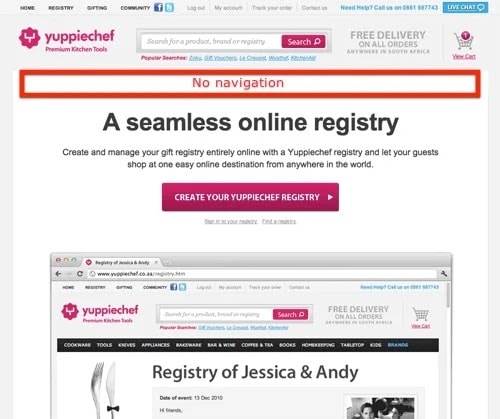
If you’re running campaigns to promote your landing page and driving traffic to it, you are missing a massive opportunity if you have a navigation menu on your page.
This is what most of us have grown up with for decades and has been drilled into our brains as the “correct way” of achieving conversion.
However, more and more people are publishing research relating to the improvement in conversions from the removal of navigation menus and other similar findings.
21. Your conversion rates will drop by 4.42% with each extra second of load time
According to Portent, your site conversion rates will drop by 4.42% on average with each extra second of load time between 0 to 5 seconds.
Load time plays an important role in determining how visitors perceive your landing page and how many return visitors you get.
If your site takes too many seconds to load, even Google will consider it slow and downgrade your rankings in its search results. Your landing page conversion rates will drop with each extra second of load time, causing you to lose valuable prospects.
22. Landing pages with compressed images have a higher conversion rate than oversized images
Unbounce found that landing pages without oversized images have a conversion rate of about 11.40%, while the pages with 1 MB+ oversized images tend to have a conversion rate of 9.80%.

Oversized images can really distract from the content. Big, flashy images — especially of people — are a common trick used in advertising to get people’s attention. That doesn’t mean they often work.
Other than being intrusive, they often lead to a longer page load wait, which also results in an abysmally low conversion rate.
While you should always take care to use high-quality images, you also need to make sure that image sizes are conducive to what you want your landing page design to be.
23. Don’t use landing pages that are unoptimized for mobile devices
If you look at the statistics, mobile devices alone drove 61% of website and landing page visits in the US in 2020. This was up from 57% in 2019.
Looking at global numbers, mobile devices accounted for 68% of website and landing page visits in 2020 – which was up from 63% in 2019.

Considering that mobile users have overtaken desktop users, it’s a given that having responsive landing pages on your website will increase your visitors.
It’s time to stop creating non-responsive landing pages that can’t be viewed on mobile devices and lose potential customers. If you want to capture the number one position in Google for your market, this is something you cannot ignore.
24. Sign-forms in landing pages using “Submit” see a decrease of at least 3% in their conversion rates
An older, albeit still relevant, study by Unbounce suggests that using intimidating text like “Submit” in your forms results in a 3% decrease in conversion rates.
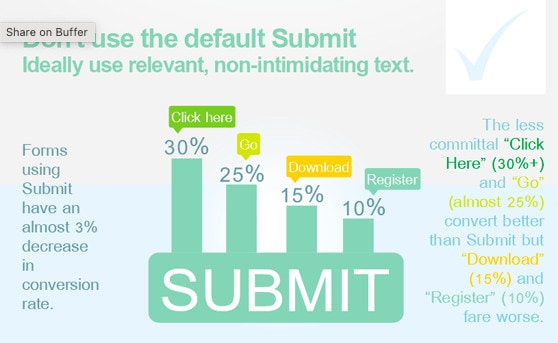
Not only does the word “Submit” intimidate the visitor from providing their details, but it also acts as a reminder that they are entering information into an internet form that can be used maliciously.
Using bland and direct keywords like “Register” and “Download” fare even worse when it comes to landing page conversions.
25. A static landing page is a big no-no
Statistics suggest that regular, static landing pages convert at 3% on average. Contrary to this, conversational and highly-targeted landing pages convert on average at 62%, which is a very drastic difference.

It takes more than just throwing up a page with nice graphics and a headline to get your desired conversion rates. Conversational landing pages have been proven to increase your conversion rates over static landing pages.
The main difference between conversational and static landing pages is that while conversational landing pages can mimic a one-on-one interaction between a business and its customer, static landing pages have limited interactivity.
26. Landing pages that invoke joy and anticipation do better than bland landing pages
A report by Unbounce suggested that landing pages with words that created a sense of anticipation and joy to their copy resulted in more conversions.

(Source)
We’ve all seen the generic, boring landing pages and quite frankly they do exactly what they say – they just leave us feeling a bit “blah”. We always go with our gut when it comes to buying anything and usually when something doesn’t meet our expectations, we somehow find a reason not to buy.
So, make sure to use words that invoke joy and anticipation for better conversion rates.
Landing Page General Trends
There are oodles of studies that focus on keywords, conversion rates, A/B testing, or even funnels. But the general landing page? One that pertains to all industries and markets? That’s where things become a bit murky.
Here are some general landing page stats and trends to help you understand the market better.
27. Interactive landing page content has been growing since 2016
Since users are looking for a better user experience, as per Smart Insights, interactive landing page content continues to grow.
More and more brands are waking up to the fact that it’s essential to have a one-on-one conversion with the target audience, compelling them to make their landing page content more personalized and interactive.
28. 39.4% of landing pages use green colored CTA button
Your CTA button color matters. As per Chartmogul, 39.4% of landing pages use the green color CTA button – followed by blue at 28.3%.
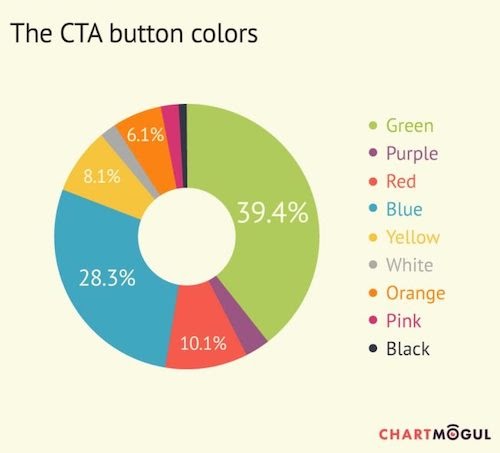
In many cases, green has been scientifically proven to be a great color for cluing users in that their actions will benefit them. If you want to get your users excited about clicking on your CTA button, make it green!
29. 77% of landing pages are home pages
Whether you are trying to sell a product or service, connect with a social following, or gather an email list, home pages are where you will likely find your visitors.
As per Nifty Marketing, 77% of landing pages are home pages. No wonder it is the page that is most frequently visited on your website.
30. eBooks lead to 55% of landing page submissions on HubSpot
Hubspot studies found that 55% of landing page submissions on Hubspot can be attributed to eBooks.
While your eBook content is intended to educate and inform, the landing page is where readers can opt-in to your list. And that’s where you can use eBooks in tandem with your landing page by offering the former as a lead magnet and acquiring more leads through your landing page.
31. 86% of the top landing pages are optimized for mobile
According to NiftyMarketing, 86% of the top landing pages are optimized for mobile.

The majority of Internet users are now mobile. If you have a website, you’ve probably tried to view it on your smartphone or tablet and wished it were easier to use and more attractive.
Landing pages aren’t different. Make sure to use landing page tools to create a mobile-friendly landing page and avoid losing customers viewing your pages on their mobile devices.
32. Landing pages usually have 11 form fields
As per PageWiz, landing pages have 11 form fields on average.
While you can make your audience fill out a considerable number of form fields, your goal should be to focus on creating a clean and concise form to collect the data you really care about. Instead of making your users fill out an unnecessary amount of form fields, try to collate information relevant to you as well as your target audience.
33. Form layout affects whether visitors choose to click on your landing page
As per Marketing Experiments, 46% of marketers are of the opinion that forms layout influences whether visitors choose to click on your landing page.
While this is a relatively older statistic, it holds true even today. In fact, where your form sits on your landing page will always affect how people interact with it.
The layout of your form determines whether visitors will complete it and whether they will be valuable leads.
34. Top landing pages rank in organic listings and maps
Landing pages can rank in organic search results, and maps and also get clicked in paid ads. In fact, as per Nifty marketing, 48% of the top landing pages ranked in organic listings and in maps.
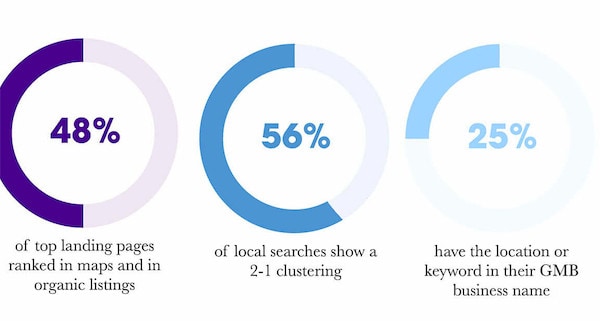
However, you can’t just add blobs of text and call it a day.
Google wants you to create an engaging landing page that will satisfy the searcher; this way the page will perform well in search engines and lead to more visitors and conversions.
35. Contact-form pages are low-converting landing pages
According to Square2marketing, “Contact Us” based landing pages have a low conversion rate. People don’t click on a contact page to enter their details. If anything, they click on a contact page to actually seek your contact details. No wonder it’s the least converting landing page.
That’s a Wrap!
To recap, once you know your metrics and where to access them, it’s easy to analyze different elements of your landing page and make necessary changes or additions.
You can track which imagery or messaging is working best, see if a certain section is being scrolled past too much, or find out how many leads you’re driving from one call to action versus another.
If this data leads you to anything, it’s that you shouldn’t be making any assumptions about why people are on your landing page.
For example, if you’re losing conversions on a particular page because they bounce when they get there, it might be the design of the page itself (or the content), but it could also be that visitors don’t find what they are looking for right away.
The possibilities for what you can discover are practically endless!
